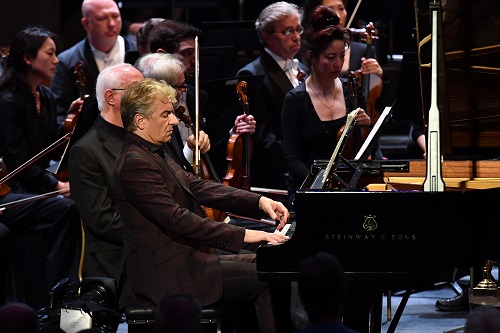
 United Kingdom PROM 60 – Bernstein, Shostakovich: Jean‐Yves Thibaudet (piano), Baltimore Symphony Orchestra / Marin Alsop (conductor), Royal Albert Hall, London, 27.8.2018. (CS)
United Kingdom PROM 60 – Bernstein, Shostakovich: Jean‐Yves Thibaudet (piano), Baltimore Symphony Orchestra / Marin Alsop (conductor), Royal Albert Hall, London, 27.8.2018. (CS)

Bernstein – Slava! A Political Overture; Symphony No.2, The Age of Anxiety
Shostakovich – Symphony No.5 in D minor Op.47
Marin Alsop is a familiar figure to Proms audiences. This concert, concluding the BBC’s celebratory Bernstein 100 weekend, marked the American conductor’s thirteenth appearance on the Royal Albert Hall podium and she has twice led the Last Night festivities, in 2013 (when she became the first women conductor to do so) and 2015. But, the orchestra of which she has been Music Director since 2007 (and where she is scheduled to continue her tenure until 2021) was making its Proms debut during a tour of Ireland and the UK, its first international trip since 2005, and the Prommers gave the Baltimore Symphony Orchestra a hearty welcome when they took to the RAH platform.
Given the ‘Renaissance-man’ range of Bernstein’s genius, interests and activities, there are myriad ways in which one might celebrate his life, career, creativity and character. The BSO chose a ‘political’ slant, and in the light of the anxiety currently being generated by what passes these days for ‘political debate’, the focus seemed apt. However, the chosen curtain-raiser was rather less than earnest in tone. Bernstein’s punning, peppy overture, Slava! A Political Overture, was written for and first conducted by Mstislav Rostropovich in 1977, during the Russian musician’s first concert as Music Director of the National Symphony Orchestra in Washington. It’s a frivolous and stylistically frothy lampooning of Washington politics which Bernstein patched together from fragments of his own Broadway flop, 1600 Pennsylvania Avenue, a quotation from Mussorgsky’s Boris Godunov, and tape-recordings of clichéd campaign slogans and hustings which culminate with a cadential flourish, “Slava!”. The BSO gave it an ebullient and effervescent reading, as Alsop – with characteristic broad, dynamic strokes and pulsing gestures – whipped up a madcap whirl of brash, brassy burlesque and dazzling dancing from the syncopated strings. But, it felt a rather light-weight prelude to the weighty deliberations to follow, and somewhat facile in today’s fraught political environment.
Alsop has been happy to take on the mantle of Bernstein-pupil/protégé/proponent, but her interpretation of the composer’s Second Symphony, The Age of Anxiety, suggested that her own penetrative interpretation and vision of her former teacher’s music deserves to be taken and admired on its own merits. This was a superbly well-integrated account of Bernstein’s Symphony for piano and orchestra – a work which took its inspiration, structure and, loosely, programme from W.H. Auden’s epic, Pulitzer Prize-winning ‘Baroque eclogue’ in which four lonely strangers spend an evening in a wartime New York bar, ruminating on their lives and the human condition.
I greatly admired Sir Simon Rattle’s performance of the Symphony last December at the Barbican, with the LSO and soloist Krystian Zimerman, but Alsop seemed to knit together the stylistically eclectic variations of Part 1 with an even more instinctive grasp of the organic relationship between the constituent parts, always driving forward, but never neglecting to illuminate the evolving stages of the journey. Transparent textures shifted imperceptibly into an ostinato of escalating menace stamped out by trombones, celli and basses, and later hollow tuba; stillness gave way to edgy fragments which accrued a frenetic energy and acceleration. Alsop’s orchestra were with her all the way: the cool clarinet dialogue at the start of the Prologue sang with a distant melancholy; the lower strings resonated with a dark, deep, warm grain, above which solos from the horn, leader Jonathan Carney and principal cellist Dariusz Skoraczewski were beautiful crafted and clearly projected.
Huge vistas seemed to open in the Dirge at the start of Part 2, the spaces filled with the strings’ impassioned G-string lament, a yearning cor anglais solo and the full weight of the brass, forming an oppressive sense of burden or obstacle. The Masque was an almost schizophrenic scherzo, skittishly light-footed then vigorously assertive, as the Baltimore players demonstrated their virtuosity and single-mindedness, with the percussion too making a notable contribution guided by the pinpoint precision of Alsop’s baton. The Epilogue initially seemed to struggle against the anxieties of the age, as Alsop embraced the darkness at the heart of the work; but, even in the most sombre, quiet passages, she sustained the flame of intensity and the coda really did seem to burn and glow with what Bernstein called a “a positive statement of the newly-recognized faith”.
And, what of the soloist, Jean-Yves Thibaudet? The French pianist recorded the Symphony with Alsop and the BSO in 2014 for Naxos’s American Classics series and here they were in perfect accord. In the opening solo passage, Thibaudet’s delicacy and light-fingered touch wonderfully evoked the poem’s tentative interplay of barely distinguishable voices, the searching melody unfolding spaciously but never languorously. This was wonderfully sensitive playing that revealed connections and echoes effortlessly, dreamily drawing the listener into the gossamer tapestry as it took shape. But, Thibaudet was just as comfortable with the jazzy, even honky-tonk, effusions of the Masque, and here his finger-tip touch made the dancing almost ineffably airy and magical. In the Epilogue the piano summoned assertiveness to challenge, in the brief coda, the orchestral sombreness, and Alsop’s drive to the blazing close was wonderfully affirmative. Thibaudet’s encore assuaged with exquisite, introspective tenderness: Richard Strauss’s arrangement of an unpublished Schubert waltz.
One of the joyful benefits, for both the curious and the scholarly, of the expansion of the internet is the accessibility of historical archives; and one of the gems of such resources is the New York Philharmonic Orchestra’s digital archive which currently offers open access to over 1.3 million pages of materials relating to the Orchestra including programmes, photographs and marked conducting scores. One of the latter is Bernstein’s own annotated score of Shostakovich’s Fifth Symphony, composed to mark Leningrad’s official commemoration of the 20th anniversary of the Bolshevik Revolution and designed to re-establish favour with the authorities after the critical censure and condemnation which had been bestowed upon his opera Lady Macbeth of Mtsensk.
I mention this fascinating source document because the opening bars of the BSO’s performance of this ‘Soviet Artist’s Response to Justified Criticism’ seemed to favour lyrical polish coupled with flowing momentum over the rugged, gritty battling that the strings’ aggressive dotted rhythms and angular melodic leaps can evoke. There was great power here, as lower and upper strings tugged against each other in the Moderato section, but the violins’ subsequent melody was restrained rather than desolate, beautiful rather than blanched. The interjection of the two bassoons was less bitterly ironic than purposefully resolute. Alsop set a fairly fast tempo, and the shift up a gear that marks the strings’ espressivo ostinato pattern almost reached a brisk two in a bar. Such features brought Bernstein’s own approach to mind.
The assertiveness of the piano’s pounding challenge initiated an accelerando of unstoppable military might, horns growling nastily. What was fast and furious threatened to become hysterical, as trumpets snarled and the xylophone rattled. I’m not sure that when Alsop exercised muscular and musical force to put the brakes on, that the ensemble was rock solid – the cross-section syncopations seemed to churn a little – but the arrival of the earth-shattering orchestral Largamente unison was certainly thrilling. The duet for flute and horn, reprising the second theme, and subsequent woodwind explorations again seemed a little precipitous – more space feels needed if the episode is really to assuage after the violent angst – but the beautiful solo violin and celeste closed the movement in uneasy, spectral quiet, spoiled only by the Prommers’ bronchial hacking.
Alsop judged the pace and spirit of the Allegretto superbly. The begrudging lower strings entered into a tetchy argument with the crisp woodwind and there was sufficient room for us to appreciate every curled lip and grimace. There were a few split notes in the horns, but the strings impressed in their unison waltz, while Carney demonstrated confidence, flair and wit in his ironic solo, relishing the glissandi and ritenuto and diminishing to a wicked whisper of a pianissimo. Alsop’s tightly controlled tempo enabled bassoon and contrabassoon duet and string pizzicati to compete for skin-pricking dryness of tone, and the nasally oboe had the last chromatic sneer.
When the Leningraders first heard Shostakovich’s Largo it reported reduced many to tears. Alsop didn’t quite match that emotional affekt – how could she, and why should she, given the starkly different context? – but she did conjure an almost suffocating expressive weight in the Symphony’s third movement, an oppressive heaviness that was coloured but not lifted by the grave duet for flutes and harp. Superb string playing added melancholic majesty which seemed to speak both of human suffering and endurance. The fragility of the final episode for strings and harp – as melody seemed to try to reassert itself only to be diffused into the ether leaving just the starlight of the harp and celeste to shine timidly through the sombreness – was not strengthened by the closing tierce de Picardie. Alsop did not allow the major tonality resolution to linger, launching immediately into the Allegro non troppo in which she kept the wildness on a tight leash at the start – indeed, I wondered when she would give free rein to the escalating violence and viciousness, but when it did come the elision from mania to quasi-chaos proved so skilfully managed as to take one almost unawares with the force of the potential apocalypse.
Always the BSO’s tone was appealing and some, like me, may have missed that certain acidic nastiness that I can’t help hearing even in the apotheotic melodic climaxes which seem to reek with rancid irony. But, Alsop’s commitment to her own vision of the work was impressive – perhaps the beauty of the horn theme and woodwind reflections in the central meno mosso episode is the point: this is what man both creates and destroys? – and it was a vision that had clearly convinced the BSO who communicated it powerfully to us. Judging by the Prommers’ rapturous reception of the BSO’s debut performance, they’d clearly like the orchestra to be invited back soon.
Claire Seymour